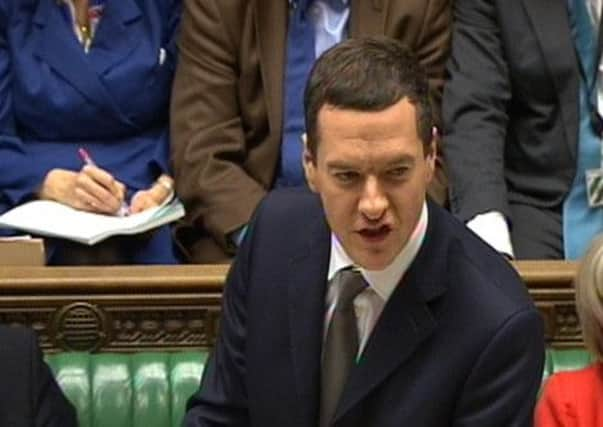Chancellor uses Budget to block Labour’s cost of living attack


The Chancellor promised to back those saving for a deposit on a home with a Government cash contribution, offered tax cuts for low earners and savers and help on the cost of filling up a car.
Mr Osborne made the most of the recent upturn in the economy with a series of moves aimed at ensuring Labour could not go into the upcoming General Election campaign claiming families have not benefited.
Advertisement
Hide AdAdvertisement
Hide Ad“Five years ago, living standards were set back years by the Great Recession. Today, the latest projections show that living standards will be higher than when we came to office,” Mr Osborne said.
In a speech which angered many Labour MPs, Mr Osborne added: “I said we would all be in this together and here is the proof.
“Compared to five years ago: Inequality is lower. Child poverty is down. Youth unemployment is down. Pensioner poverty is at its lowest level ever. The gender pay gap has never been smaller. Payday loans are capped. And zero hours contracts regulated.”
In a deeply political move, Mr Osborne revealed he will cut pension tax relief, a move that will save the taxpayer £600m by 2020. That same sum had been earmarked by Labour as a way to pay for a reduction in tuition fees.
Advertisement
Hide AdAdvertisement
Hide AdPlans for a saving revolution were also unveiled as a string of incentives aimed at making it easier for people to build up their nest eggs were announced
A new tax-fee allowance of £1,000, a Help to Buy Isa for people aspiring to get on the property ladder and a further relaxation of the Isa rules were all unveiled in the Budget.
The Chancellor said that a new personal savings allowance will take 95% of taxpayers out of savings tax altogether, with around 17 million people benefiting.
From April 2016, a tax-free allowance of £1,000, or £500 for higher rate taxpayers, will be introduced for the interest that people earn on their savings.
Advertisement
Hide AdAdvertisement
Hide AdAnd from this autumn, new Help to Buy Isa accounts will be made available through banks and building societies.
The new Help to Buy Isa will help people to save for a deposit for their first home.
Under the new scheme, first-time buyers who want to purchase a UK property can save up to £200 a month towards their home with a Help to Buy Isa and the Government will boost their savings by £50 for every £200 people save.
The maximum bonus size is £3,000 per person and the bonus will be paid when the saver buys their first home.
Advertisement
Hide AdAdvertisement
Hide AdThe bonus is available on house purchases of up to £450,000 in London and £250,000 outside London.
And Some 27 million people will receive a tax cut and 3.7 million be taken out of income tax altogether as a result of George Osborne’s announcement that the threshold for paying the basic 20p rate will rise to £11,000 by 2017, according to Treasury calculations.
Labour former Treasury minister John Healey said the Chancellor had not resolved structural weaknesses in Britain’s economy, such as a lack of demand for labour which manifests itself in low-wage jobs, low capital spending, under-par exports and failure to reduce the deficit.
The South Yorkshire MP said: “The difference between the parties is that we will deal with it in a more balanced way.
Advertisement
Hide AdAdvertisement
Hide Ad“There is a choice - you can do it with tax rises that are fair, you can do it with spending cuts and you can also do it with efficiencies as well, and we will do what we need to do in a more balanced way.”